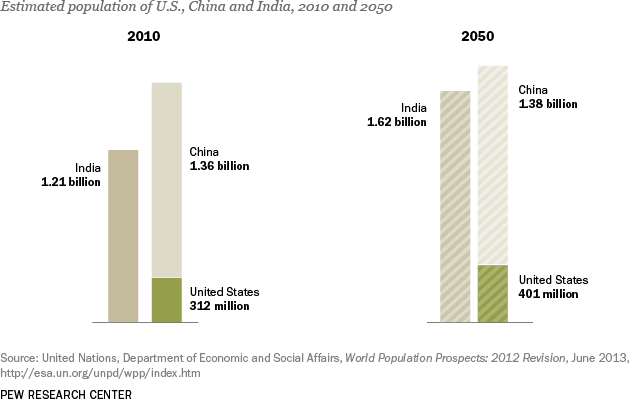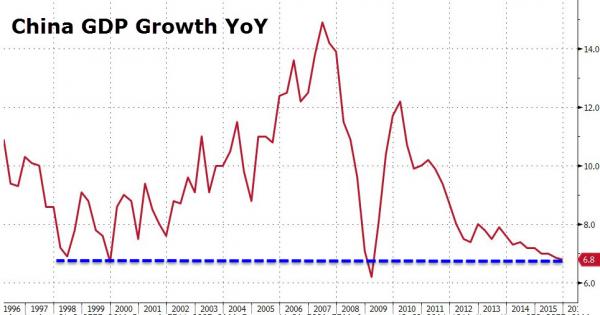This will be the biggest challenge for developed nations over the next hundred years: depopulation.
Expect strange things to happen in the western world and developed nations in Asia over the next fifty years — marked by unusual foreign policy moves — and a craven, almost desperate clamoring for middle eastern, south american and african migrants to replace their withering and decadent societies.
Why?
Credit expansion, or at a minimum, stasis.
Due to one of the lowest birth rates in the world (1.5p per family), thanks to the one child policy, China is now considering offering incentives to its citizens to get out there and ‘screw for China’, a la Denmark.
Source: Reuters
The potential move was revealed by Wang Peian, vice-minister of the National Health and Family Planning Commission at a social welfare conference on Saturday, the newspaper said on Tuesday.
Birth rates rose to 17.86 million in 2016, the highest level since 2000, after the country issued new guidelines in late 2015 allowing all parents to have two children amid growing concerns over the costs of supporting an aging population.
“That fully met the expectations, but barriers still exist and must be addressed,” Wang was quoted as saying.
“To have a second child is the right of each family in China but affordability has become a bottleneck that undermines the decision.”
A poll conducted by the commission in 2015 found that 60 percent of families surveyed were reluctant to have a second baby largely due to financial constraints.
China’s birth rate, one of the world’s lowest, is fast becoming a worry for authorities, rather than the achievement it was considered at a time when the government feared over-population.
China began implementing its controversial “one-child policy” in the 1970s in order to limit population growth, but authorities are now concerned that the country’s dwindling workforce will not be able to support an increasingly aging population.
Elon Musk has been an outspoken advocate about depopulation and ‘population implosion’.
Watch:
By 2050, India will surpass China in population — essentially leveling China’s population flat for the next 33 years.
The deleterious effect upon China’s demographic trends was predicted by Brookings Institute in 2010 — saying its ‘dividend growth rate’ would erode to the point that by 2013 it would hamper economic growth. This is not only a Chinese problem, mind you, but a developed world problem. Both Japan and Italy is expected to lose half its population over the next 40 years — based on current trends. If this persists, what do you think this will do to global GDP?
Looks legit to me.
Source: Brookings Institute (2010)
By 2013 China’s demographic dividend growth rate will turn negative: That is, the growth rate of net consumers will exceed the growth rate of net producers. Starting in 2013, such a negative growth rate will reduce the country’s economic growth rate by at least half a percentage point per year. Between 2013 and 2050, China will not fare demographically much better than Japan or Taiwan, and will fare much worse than the United States and France.
As a result of China’s very low fertility over the past two decades, the abundance of young, inexpensive labor is soon to be history. The number of workers aged 20 to 29 will stay about the same for the next few years, but a precipitous drop will begin in the middle of the coming decade. Over a 10-year period, between 2016 and 2026, the size of the population in this age range will be reduced by about one-quarter, to 150 million from 200 million. For Chinese aged 20 to 24, that decline will come sooner and will be more drastic: Over the next decade, their number will be reduced by nearly 50 percent, to 68 million from 125 million.
Such a drastic decline in the young labor force will usher in, for the first time in recent Chinese history, successive shrinking cohorts of labor force entrants. It will also have profound consequences for labor productivity, since the youngest workers are the most recently educated and the most innovative.
As the young population declines, domestic demand for consumption may weaken as well, since young people are also the most active consumers of everything from wedding banquets to new cars and housing units. And because China is a major player in the global economy, the impact of the country’s demographic changes will not be limited by its borders.
Fragile families, fragile society
So far, observers of China’s demographic changes have focused most of their attention on consequences at the aggregate or societal level: the size of the labor force, of the elderly population, and of the number of men who will not be able to marry. Worries at this level of analysis generally relate to the country’s future economic growth and social stability. But the challenges that China will face as a result of its changing demographics go far beyond economic growth and other aggregate concerns.
China’s unprecedented population control policy, the one-child policy, turned 30 this year. It has forcefully altered the family and kin structure of hundreds of millions of Chinese families. And families, in addition to their other functions, are first and foremost the primary source of support for dependents, the young and the elderly.
Although the full extent of the one-child policy’s societal consequences will not be known until later, it is safe to predict that the social costs that China will need to pay, especially in terms of family support for aging parents, will be exceedingly high. In no small part due to implementation of the one-child policy, China by 2005 had accumulated nearly 160 million only children aged 0 to 30. That number has further grown in the past five years. These figures imply that over 40 percent of Chinese households have only one child.
More generally, ever more Chinese parents in the future will not be able to count on their children in their old age. And many parents will face a most unfortunate reality: outliving their children and therefore dying alone. Given the current mortality schedule, the likelihood that an 80-year-old Chinese man will see his 55-year-old son die before he does is 6 percent. Because women live longer, the likelihood that an 80-year-old woman will outlive her 55-year-old son is 17 percent.
Because of China’s continued mortality decline, and especially its sustained fertility decline to below replacement levels, the country has effectively entered an era of population decline.China’s current TFR of 1.5 implies that, in the long run, each future generation will be 25 percent smaller than the one preceding it. China’s population is still growing, albeit very slowly, because the country still has a relatively young age structure, which produces more births than deaths, even though on average each couple has fewer than two children. Had it not been for China’s relatively young age structure, the population would have begun declining in the early 1990s, almost two decades ago. The current growth, in other words, is a result of population momentum.
The same force of momentum will work in the opposite direction soon. Given current mortality and fertility rates, and with a population age structure that is growing increasingly older, the number of deaths will soon exceed the number of births. China’s population is likely to peak less than 15 years from now, below a maximum of 1.4 billion. After that will come a prolonged, even indefinite, population decline and a period of accelerated aging.
Even if China can restore fertility to replacement level within 10 years after the country reaches its population peak, population will still exhibit a decline nearly half a century long, with a net population loss of over 200 million, if not more. The median age of the Chinese population, at its peak, could be as high as 50 years.
China is by no means unique in experiencing below-replacement fertility. In the past decade, below-replacement fertility has become a new global reality. Whereas in some parts of the world high fertility rates continue to pose severe challenges to women and children’s health, for more than half of the world’s population, below replacement fertility is now the norm.
In Europe, North America, and East Asia, prolonged below-replacement fertility has already set in motion a negative population growth momentum.In the most extreme cases, such as Italy and Japan, population could be reduced by half in as few as 40 years or so if current rates of reproduction persist. A gradual but substantial reduction in population, especially with a concomitant aging of populations in the world’s richest countries, constitutes an unprecedented shift that is redefining the global demographic, economic, and political landscape.
What makes China unique, however, is that it still has a state policy, unique in human history, that restricts the majority of Chinese families to one child per couple. At the time the policy was announced 30 years ago, it provoked great controversy both within and outside China; over the years it has extracted great sacrifices from Chinese families and individuals, especially from women. And although the policy was designed as an emergency measure to slow down China’s population growth, and was intended to last for only one generation, the government has not yet shown the willingness, or courage, to phase it out.
China’s slow recognition and inaction in the face of its impending demographic crisis—inaction that persists despite appeals by almost all the country’s population experts to phase out the one child policy quickly—reflect policy makers’ lack of understanding of the changing demographic reality. Inertia also results from the resistance of the country’s birth-control bureaucracy, which formally employs half a million people.
This exemplifies a characteristic feature of China’s regime—relegating difficult, long-term, structural challenges to the back burner, while giving priority to short-term crisis management and concerns about stability. The looming demographic crisis will largely define China in the twenty-first century. Given that demographic changes take time to develop, and that their ramifications are not only massive but also long-lasting, China’s inaction has already proved costly—and will only grow more so the longer it persists.
In the words of the immortal Bill the Butcher, ‘this is a kill.’
If you enjoy the content at iBankCoin, please follow us on Twitter









Well hell! I thought it was illegal to have more than one kid in China. When did that change?
Great post.
Is any of this real? India is already crowded. China will make babies in a pigs cunt if needed. Russia looks like the play.
You’ll be pleased to know, Mr. Fly, that this pig is performing prodigious service to keep those population numbers up.
Good to see Wang Peian is heading this.
Assisted by Wei Fukemyung
conveniently Arab countries are omitted from the results
In 2050 Bannon will be dead and the US will be decidedly majority non-white. The most multi-cultural nation on earth. What’s the point of this racist short sighted white nationalism? https://www.washingtonpost.com/news/the-fix/wp/2015/04/03/what-america-will-look-like-in-2050-less-christian-less-white-more-gray/?utm_term=.e7b44466c552